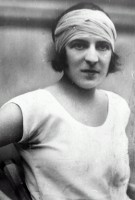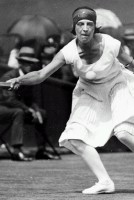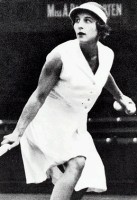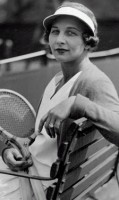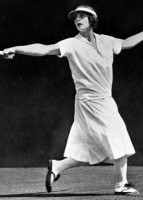|
Excerpts from The Goddess and the American Girl: The Story of Suzanne Lenglen and Helen Wills by Larry Englemann, 1988, Oxford University Press, NY Out of print, but still available used from Amazon.com via the link above. The Goddess and the American Girl differs from most sports biographies in having a useful index, rare in this genre. It also has a useful, comprehensive list of sources (although the text is not linked to the sources via annotation). Although the book focuses on the lives of two subjects, it also contains much information about other players, such as Molla Mallory, Helen Jacobs, Hazel Wightman, and Alice Marble. The information presented in the book is excellent, but the presentation itself is unfortunately verbose. The 440 pages would make more interesting reading if cut to 300, or even fewer, pages, without necessarily losing any real information. But although the writing is laced with superfluous sentences and phrases, The Goddess and the American Girl is fairly clear and readily understandable nonetheless. Numerous tennis matches of great historic importance are described in substantial, if wordy, detail, making this book well worth reading. The index and source list also make it a very useful reference. The photos of Suzanne Lenglen and Helen Wills on this page are from Wimbledon.org
|
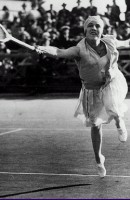 Suzanne Lenglen |
|
Suzanne Lenglen: Early Years (pages 7-8) Suzanne Rachel Flore Lenglen was born in Compiègne, France on May 24, 1899... Papa Lenglen, a businessman of some means, managed the omnibus concession he had inherited from his father. The enterprise prospered, and soon after Suzanne's birth Papa sold it and moved with his wife, Anais, and their daughter to a rustic villa in Maretz-sur-Matz near Compiègne. There the Lenglens lived a life of pleasant leisure, dividing their time between the new home in the Oise and a small vacation villa in Nice... ...Papa later remembered the fateful day--in June, 1910--when he presented his daughter with her first tennis racket. It was an inexpensive instrument he had purchased in a toy shop in Compiègne... |
|
Lacoste Watches Lenglen (pages 5-6) Tennis star René Lacoste remembered first falling under her spell in 1921. In the spring of that year young Lacoste traveled with his parents to Saint-Cloud. After promising to return in a few minutes, Lacoste was permitted to enter the Stade Français to watch part of the final match for the World Hard Court Championship between Suzanne Lenglen and the American champion, Molla Mallory... "At first," Lacoste said of his initial glimpse of the French woman, "I was disappointed, as were most of those who saw her for the first time, after having heard so much about her." He expected to see a woman execute extraordinary tennis strokes. But Suzanne did not. He found "she played with marvelous ease the simplest strokes in the world. It was only after several games that I understood what harmony was concealed by her simplicity, what wonderful mental and physical balance was hidden by the facility of her play."... |
|
Lenglen's Health (pages 46-47) Suzanne Lenglen stood about five and a half feet tall. She was a muscular, large-boned girl with gray eyes, raven hair, and a sharp, birdlike profile. She had an unusually long nose and large irregular teeth that protruded unhandsomely from her mouth even when she smiled. Paul Gallico recalled that she had "a hatchet face and a hook nose"; while Hazel Wightman, a lifelong friend of Suzanne, described her by simply saying, "She was homely--you can't imagine a homlier face." Bill Tilden summed up her appearance by observing, "Heaven knows no one would call her beautiful." Yet despite her physiognomy, she had a rather attractive and healthy demeanor in the early 1920s. Because she eschewed the traditional long-sleeved blouse and wide-brimmed hat of the other players, her face and arms were deeply tanned. But the pressure of practice and play gradually eroded her physical health as well as her emotional stability. By the mid-1920s, when she stood at the pinnacle of her career, she looked thirty years older than her actual age. There were deep dark circles under her eyes and her skin was wrinkled and creased. The constant exposure to the sun caused her complexion to deteriorate rapidly. She found it necessary to wear ever heavier layers of powder and makeup... And yet nearly eveyone who watched her perform pirouettes on the tennis court remarked that her lack of physical beauty was largely overcome by her grace and poise and movement... |
After 1923, demand for Lenglen and Wills to play each other kept growing. They finally met in the final of a tourney at the Carlton Club in Cannes, France, on February 16, 1926. There were 4000 spectators.
|
The "Match of the Century" ...In the fourth game Lenglen seized control of the [1st] set. She exchanged long backhand drives with Wills, staying behind the baseline on her backhand side, clearly tempting her to go for the easy winner down the forehand side. But Helen Wills did not go for those winners. She hit ball after ball deep to Lenglen's backhand... one newsman wrote that Helen Wills played as though she believed Suzanne Lenglen's weakness was her backhand. It wasn't... Lenglen took... a 3-2 lead. |
Lenglen won the 1st set 6-3. Between sets she had "two deep swallows" from her "emergency kit"--said to be iced cognac. "There was a noticably new spring in her walk when she returned to the baseline to receive Helen's serve."
|
Wills served the opening game of the second set. She sliced her first service wide to Lenglen's forehand, drew the Maid Marvel off the court, then moved in quickly and took the return with a winning volley to the backhand side. The crowd loved it. She took three more points in rapid succession and without much difficulty. The last point of the game was nearly unbelievable: a beautiful topped backhand shot straight down the line. The shot completely outwitted Lenglen and left her standing flatfooted in the backcourt. Wills had raised the level of play once again. [After 7 games the score stood at Wills 4, Lenglen 3...] Before serving the eighth game, Suzanne Lenglen took another gulp from emergency kit. Then she served and won the first point. But Helen Wills again came back and took two points and the lead. The fourth point of the game involved an exceptionally long rally. Then Lenglen returned one of Will's long forehand shots with a powerful forehand angled return. Helen moved for the ball near the juncture of the service line and the sideline. But then she held back on her swing and watched the ball bound well outside. Newsman Don Skene, sitting near where the ball came down, watched it hit wide by "three inches at least." Associated Press correspondent Ferdinand Tuohy also had no doubt about the ball. "It struck far outside," he wrote... Cyril Tolley, the line judge, remained silent. Helen Wills stood for a moment near where the ball went down, listening for the call. Then, in an extremely rare gesture, she abandoned her silence and her serenity and her poker-faced look. In a loud and clear voice, almost a desperate shout that betrayed her anger, she demanded of Tolley, "What did you call that ball?" "Inside," he responded. "The shot was good!" ...Fred Moody, Helen's regular Riviera escort, was sitting near the line too, and he knew that the ball was out. He had no doubts at all. "The ball was out and Helen was robbed..." ...In the eleventh game Lenglen... broke Wills service at 30 and appeared to be in control of the match. She now led 6-5 with her own service coming. Then, with renewed confidence she jumped out to a 40-15 lead and double match point in the twelfth game. She hit her first match point down the middle to Wills's backhand and then stayed back for the return. There were several long exchanges as Helen tried pull Suzanne into the forehand corner with some powerful crosscourt blasts. Eventually, Wills sent a sizzling drive deep into that corner. Lenglen moved over for the return, hesitated, and then stopped. Then she heard a wonderful wonderful wonderful sound as a loud and clear voice roared "Ouuuut!" Suzanne Lenglen flung the remaining two tennis balls she held high into the sky and skipped quickly to the net, a smile of relief on her face, her right hand extended. Helen Wills met her at the net and grasped her hand... The tennis court was almost instantly engulfed by a mob... Meanwhile, from the far end of the court Lord Charles Hope frantically fought his way through the crowd, swimming through the shouting celebrants to the umpire's chair. When he was within a few feet of Commander Hillyard, he shouted out a shocking statement. "The shot was good!" he said. "I didn't call it out!" ...once Hillyard was certain that he had heard Hope right, he turned apologetically to Suzanne. "The match is not over," he said cautiously. "That ball was good." Suzanne Lenglen gave the umpire a stunned look as the remark registered. The she responded in a calm and deliberately measured tone, "Then we must go on."... ...Helen Wills... saved the second match point and brought the game to deuce. Then with her hard drives and sharp crisp angles she took two more points and the twelfth game. Six to six. ...Suzanne Lenglen [now leading 7-6] served cautiously in the fourteenth game, placing each service with meticulous care... Finally, with one of her pretty placements she arrived once more at match point. This was fifteen minutes after she believed she had won the match. She served to Wills's backhand once again and took the strong return with her forehand, punching over a drop shot just to the left of the center line. Wills responded wtih a running desperate save that was high over the net. Too high... Lenglen... caught it near the service line, shoulder high and slapped it back at an angle across the court for a winner. The match was over. |
Suzanne Lenglen won 6 Wimbledon singles titles in her career. She played in the US Nationals at Forest Hills only once, and then only one match, on Tuesday, August 16, 1921. Lenglen was scheduled to play Eleanor Goss in the opening round, but Goss defaulted shortly before the match was to start. Because the draw was unseeded, her 2nd round opponent was defending champion Molla Mallory. Tourney officials moved that match up to Tuesday, purportedly so that the crowd of 8000 expecting to see Lenglen play would not be disappointed. Mallory won the 1st set 6-2, then, after serving a double fault to go to 0-30 in the 1st game of the 2nd set, Lenglen retired from the match, telling the umpire, "I cannot go on. I am really too ill." Lenglen would never again play in the US Nationals at Forest Hills.
Although Lenglen won the "Match of the Century" versus Helen Wills in 1926, Wills fame grew, while Lenglen played less and less. During the 1926 Championships at Wimbledon Lenglen was not informed of a schedule change, then said she could not play the match at the rescheduled time. Officials claimed they did not receive notice of this. Queen Mary, for whom the schedule had been changed so she could see Lenglen play, was kept waiting for 90 minutes when Lenglen did not show up, then told the match would be postponed. After defeating Mrs. Evelyn Dewhurst 6-2, 6-2 in the rescheduled match, Lenglen withdrew from Wimbledon, pleading illness again.
Suzanne Lenglen page at the International Tennis Hall of Fame
Great Wimbledon Champions: Suzanne Lenglen
Helen Wills page at the International Tennis Hall of Fame
Find more books by Larry Englemann at Amazon.com
Find tennis shoes made by: adidas -- Nike -- Fila -- Reebok
Find tennis racquets made by: Yonex -- Wilson -- Head -- Prince -- Babolat
Find tennis balls made by: Wilson -- Dunlop -- Penn -- Tretorn -- Slazenger
Tennis pages at quickfound.net:
- Tennis History Book Excerpts:
The Goddess and the American Girl: The Story of Suzanne Lenglen and Helen Wills by Larry Englemann
Tennis Styles and Stylists by Paul Metzler
Chrissie: My Own Story by Chris Evert with Neil Amdur
Courting Triumph by Virginia Wade with Mary Lou Mellace
The Game by Jack Kramer about Pauline Betz & Gussy Moran & more
Beyond Center Court: My Story by Tracy Austin with Christine Brennan
Courting Danger by Alice Marble with Dale Leatherman
Evonne!: On the Move by Evonne Goolagong with Bud Collins
Court On Court: A Life in Tennis by Margaret Smith Court
Hard Courts by John Feinstein about Mary Carillo & John McEnroe & more
Ladies of the Court by Michael Mewshaw about Mary Joe Fernandez & more
A Long Way, Baby by Grace Lichtenstein about Rosie Casals
Monica by Monica Seles & My Aces, My Faults by Nick Bollettieri Seles at Bradenton
Tough Draw by Eliot Berry about Nick Bollettieri
The Courts of Babylon by Peter Bodo: Tournament Draws
The Courts of Babylon by Peter Bodo: Dawn of the Pro Tours
- Tennis Articles
1946 TIME: Pauline Betz, Doris Hart, Beverly Baker, Gussie Moran
plus current tennis article feed
1951 & 1952 TIME: Maureen Connolly - Tennis News and Links
- WTA 2004 Desktop Wallpaper
- Justine Henin-Hardenne Desktop Wallpaper
- Maria Sharapova Desktop Wallpaper
- Anastasia Myskina Desktop Wallpaper
- Anna Kournikova News and Links
- Anna Kournikova Desktop Wallpaper
- Martina Hingis News and Links
- 2004 WTA Player Interview Videos
This page's URL is: //tennis.quickfound.net/history/suzanne_lenglen_helen_wills.html
